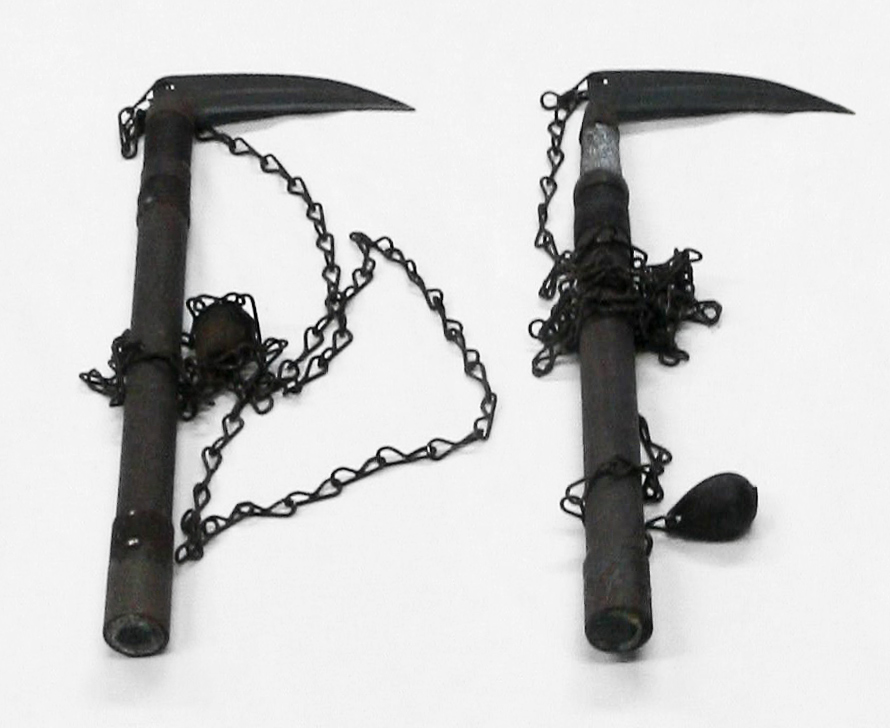|
Yamada Shinryukan
Yamada Shinryukan was a semi-famous swordsman following the Edo period of the 17th century of Japan. Shinryukan was a noted teacher of the kusarigama (Which consists of a kama with a long chain with a weight at one end attached to it.) who killed many rival swordsmen. Shinryukan was finally defeated when he fought against the swordsman Araki Mataemon was a Japanese samurai active in the early Edo period. Araki Mataemon was the founder of the koryū martial art Yagyū Shingan-ryū, known sometimes as Yagyū Shingan-ryū Taijutsu. Araki Matemon studied Yagyū Shinkage-ryū under Yagyū Mune .... References ''Secrets of the Samurai'' Yamada Shinryukan {{Japan-martialart-bio-stub ... [...More Info...] [...Related Items...] OR: [Wikipedia] [Google] [Baidu] |
Edo Period
The or is the period between 1603 and 1867 in the history of Japan, when Japan was under the rule of the Tokugawa shogunate and the country's 300 regional '' daimyo''. Emerging from the chaos of the Sengoku period, the Edo period was characterized by economic growth, strict social order, isolationist foreign policies, a stable population, perpetual peace, and popular enjoyment of arts and culture. The period derives its name from Edo (now Tokyo), where on March 24, 1603, the shogunate was officially established by Tokugawa Ieyasu. The period came to an end with the Meiji Restoration and the Boshin War, which restored imperial rule to Japan. Consolidation of the shogunate The Edo period or Tokugawa period is the period between 1603 and 1867 in the history of Japan, when Japan was under the rule of the Tokugawa shogunate and the country's regional '' daimyo''. A revolution took place from the time of the Kamakura shogunate, which existed with the Tennō's court, to the Tok ... [...More Info...] [...Related Items...] OR: [Wikipedia] [Google] [Baidu] |
Kusarigama
A is a traditional Japanese weapon that consists of a ''kama'' (the Japanese equivalent of a sickle or billhook) on a kusari-fundo – a type of metal chain (''kusari'') with a heavy iron weight (''fundo'') at the end. The ''kusarigama'' is said to have been developed during the Muromachi period. The art of handling the kusarigama is called ''kusarigamajutsu''. History The researcher Nawa Yumio believes that the ''kusarigama'' was based on the ''jingama'', a tool that resembles a sickle, which was used to cut through a horse's ropes in the case of a fire. The ''jingama'' could also be used as a weapon and according to Nawa, the tool might have been combined with a ''konpi'' (棍飛) which is a chain that contained a weighted end and a chain around the user's wrist. People would wield the weapons with both hands to protect their horses against criminals. Another theory is that the ''kusarigama'' is based on the ''tobiguchi'' ( :ja:鳶口), which is a type of axe that had a "stou ... [...More Info...] [...Related Items...] OR: [Wikipedia] [Google] [Baidu] |
Araki Mataemon
was a Japanese samurai active in the early Edo period. Araki Mataemon was the founder of the koryū martial art Yagyū Shingan-ryū, known sometimes as Yagyū Shingan-ryū Taijutsu. Araki Matemon studied Yagyū Shinkage-ryū under Yagyū Munenori and later received permissionSkoss, Diane (Editor). 1997. ''Koryu Bujutsu''.Classical Warrior Traditions of Japan, volume 1, p. 85. New Jersey, Koryu Books. from Yagyū Jūbei to use the Yagyū family-name in the Yagyū Shingan-ryū. Araki Mataemon was a very strong warrior, and his feud against the samurai Kawai Matagorō is one of the most famous in Japan, called Igagoe vendetta The Igagoe vendetta was a vengeance incident in Japan in 1634, where the murder of a retainer was avenged by his older brother. The event happened in the town of Iga-Ueno near Iga Pass. The vendetta is known as one of the three major vendetta inc .... Matagoro killed Gendayu, the little brother of Mataemon's brother-in-law, Watanabe Kazuma. Becoming a mu ... [...More Info...] [...Related Items...] OR: [Wikipedia] [Google] [Baidu] |
